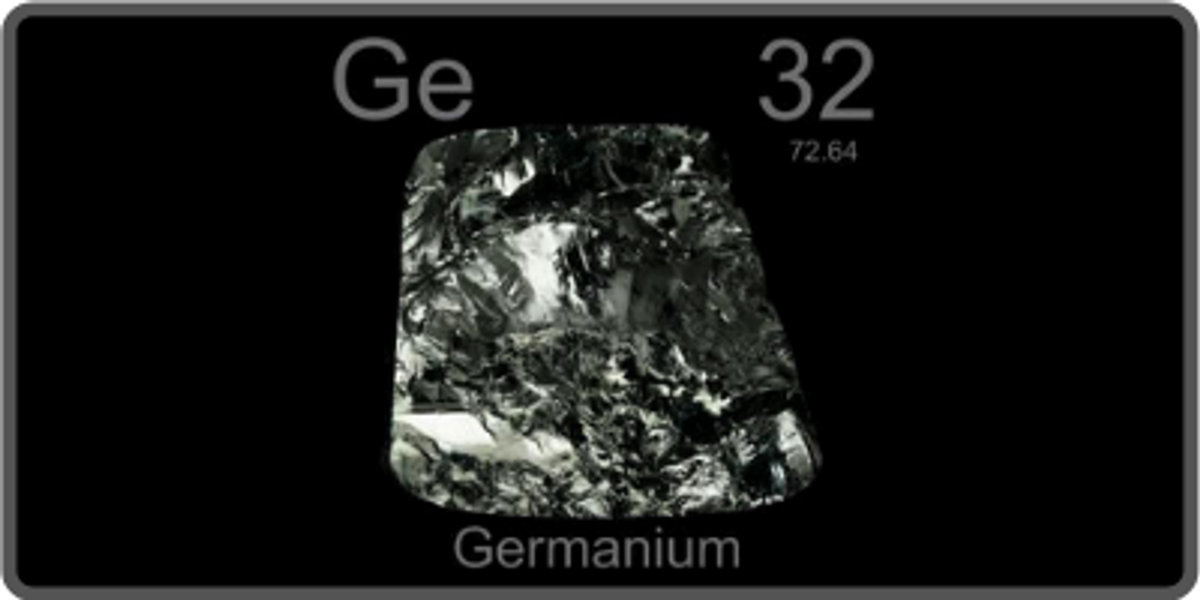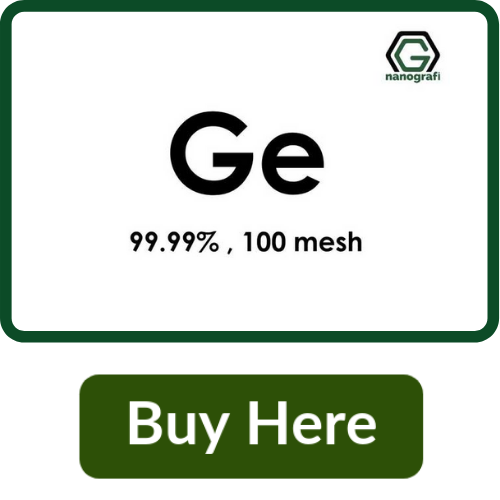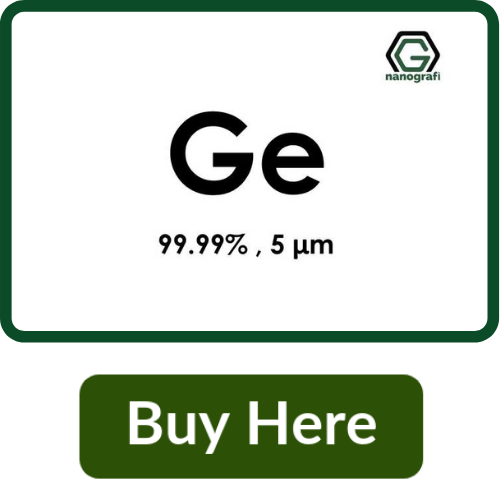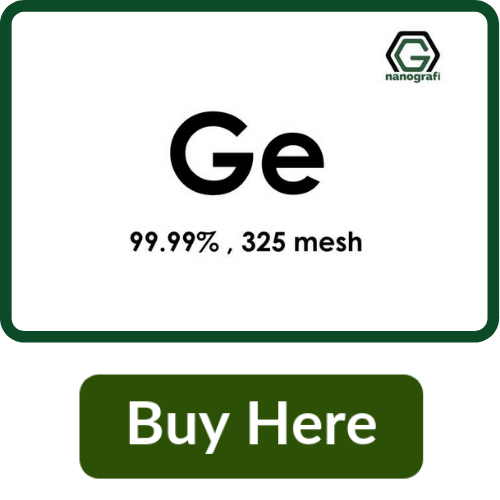Analyzed: Germanium Powder
Germanium powder is an important chemical with a variety of applications. It was discovered by German chemist Clemens Alexander Winkler in 1866. It is one of the elements, whose properties Mendeleev predicted. Its name comes from Germania, the Latin name of Germany. It is a silver-gray, hard and very brittle semimetal with a diamond-like structure. It is widely used in semiconductors. Due to its transparency against infrared radiation, it is of great importance for spectroscopy. It is obtained from the refining of copper, zinc, and lead. Let’s have a deeper look into the discovery, properties, and applications of Germanium powder.
Germanium is an element of silver-gray, brittle, crystalline and semiconductor structure. It is distributed over a large area of the earth's crust - in small quantities - generally in the form of sulfur or associated with the sulfides of other elements such as copper or zinc. It has atomic number 32, atomic weight 72.59, group 14, period 4, and symbol Ge. Due to its semiconductor characteristics, it is used together with Silicon and is used in the manufacture of electronic devices.
Let’s find out the position of Germanium in the Periodic Table
Germanium in the Periodic Table
Germanium exists below the silicon and above the tin, to the right of the gallium and to the left of the arsenic, where the transition occurs from metals to nonmetals. Due to its position in the Periodic Table, it acquires physical and chemical properties as a metal under very special conditions. Among the elements of the Periodic Table, Germanium occupies an especially important role in the history of science. As we have seen, its discovery was decisive to eliminate any doubt about the periodicity of the chemical elements discovered by Mendeleev.
Discovery
Germanium was discovered through the mineral known as argyrodite, consisting basically of silver and sulfur. When studying this mineral, Clemens Alexander Winkler (1838-1904) realized that the individually measured silver and sulfur content was not sufficient to complete the total mass, so he suspected the presence of an additional element. Winkler was able to purify this element on February 6, 1886, and suggested naming it Germanium. In the configuration of Mendeleev's table, germanium corresponded to Eka silicon (silicon has an atomic number 14, in group 14, period 3 of the contemporary table), so it currently occupies the square just below silicon.
The first transistor (1946) was built with germanium, semiconductor technology has made significant progress with this element as a protagonist and, if that were not enough, it is used in the detection of neutrinos, by far the most elusive particles we know today. It turns out that these particles have such a small mass that at first it was thought that they lacked it. They are of three types, the first one was detected in 1956. Neutrinos are electrically neutral and move almost as fast as light, so it is so difficult to detect them. The combination of a neutrino with a gallium atom results in an unstable germanium atom, whereby a given concentration of gallium can be used to detect neutrinos by identifying the presence of germanium combined with the decrease of gallium.
Abundance and obtaining
The only profitable minerals for the extraction of Germanium are Germanite (69% Ge) and ranierite (7-8% Ge); it is also present in coal, argirodite and other minerals. The largest amount, in the form of an oxide (GeO2), is obtained as a byproduct of obtaining zinc or coal combustion processes (the process under development is in Russia and China).
The purification of Germanium passes through its tetrachloride that can be distilled and then reduced to the element with hydrogen or elemental magnesium. This technique allows the production of ultra-pure germanium. With 99.99% purity, for electronic uses, it is obtained by refining by fusion by zones resulting in crystals of 25 to 35 mm used in transistors and Diodes; with this technique, impurities can be reduced up to 0.0001 ppm.
In 1997 the commercial cost of germanium was 3 US dollars per gram. In 2000 the price of germanium was $ 1.15 per gram (or $ 1,150 per kilogram)
Main features of Germanium
It is a hard solid crystalline metalloid, glossy gray, crisp white, which retains the brightness at ordinary temperatures. It has the same crystal structure as the diamond and resists acids and alkalis. It forms a large number of organometallic compounds and is an important semiconductor material used in Transistors and Photodetectors. Unlike most semiconductors, Germanium has a small bandgap so it responds effectively to infrared radiation and can be used in low-intensity amplifiers.
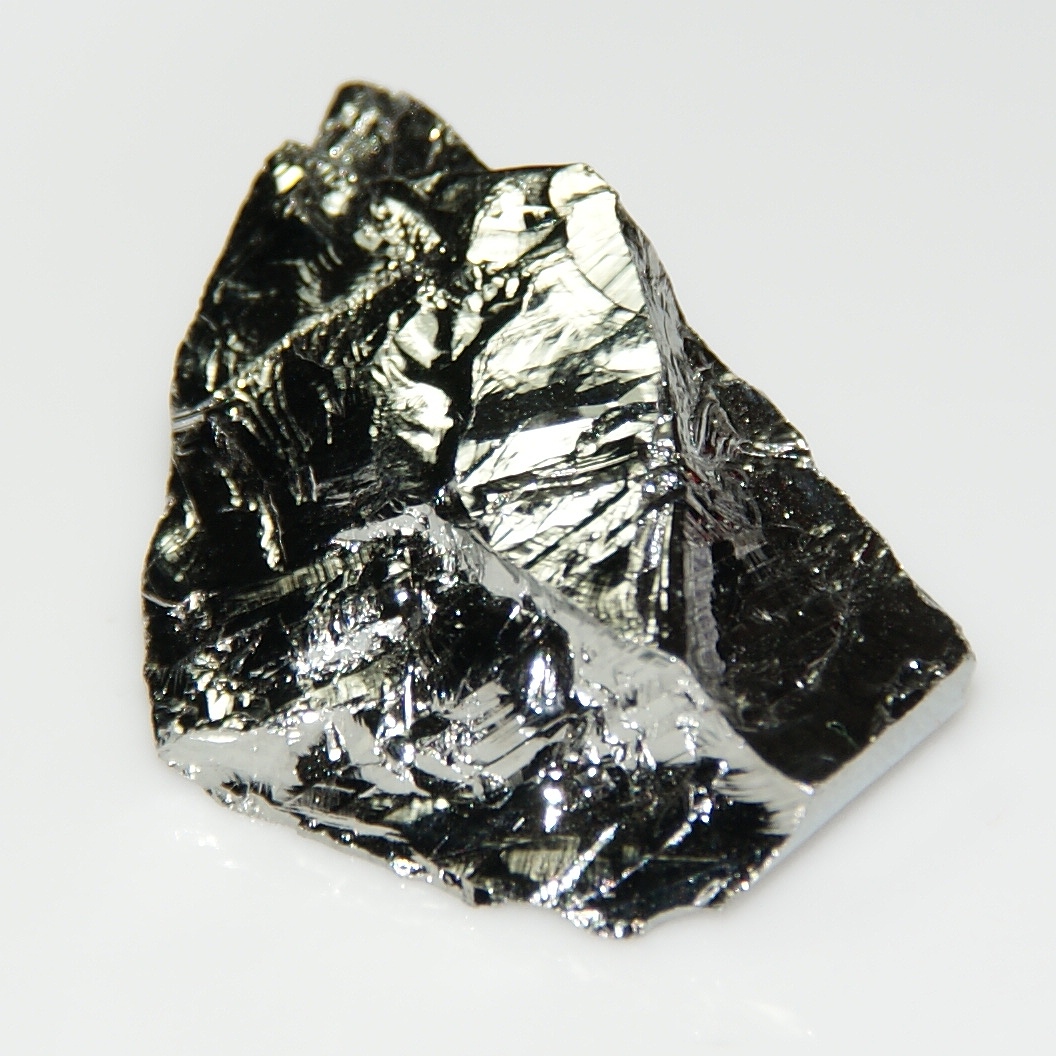
Isotopes
Germanium has five stable isotopes, the most abundant being Ge-74 (35.94%). 18 Germanium radioisotopes have been characterized, the Ge-68 being the one with the longest half-life with 270.8 days. In addition, 9 metastable states are known.
Applications
Germanium is a hard gray-white substance that meets the minerals of zinc, silver, lead, and copper. The main production of germanium is as a byproduct of obtaining zinc ore and no more than 100 tons are produced per year. It is very demanded its important applications. Its utility is very diverse, although sometimes it is limited by the high cost it has, however, it is used in combination with silicon in high-speed integrated circuits to achieve an increase in its performance. If you've ever wondered what Germanium is for, here is a list of its possible uses:
- Germanium powder is used as a semiconductor material. It is generally used, together with silicon, in high-speed integrated circuits to improve its performance. In some cases, it is considered replacing silicon with germanium to make miniaturized chips.
- Some guitar pedals contain germanium powder transistors to produce a characteristic distortion tone.
- It can be used in solar panels. Mars scout robots contain germanium powder in their solar cells.
- It is used as a hardening element of aluminum, magnesium, and tin.
- In jewelry, the Au alloy with 12% Germanium is used.
- Germanium tetrachloride is a Lewis acid and is used as a catalyst in the synthesis of Polymers (PET). It is also used in fluorescent lamps and some LEDs.
- Germanium powder combines with oxygen for use in camera lenses and microscopy. It is also used to manufacture the fiber optic cable core.
- Because it is transparent to infrared radiation, it is used in the form of monocrystals in infrared spectroscopes (lenses, prisms, and windows) and other optical devices, among which are extremely sensitive infrared detectors.
- Germanium powder is used in airport control to detect sources of radiation.
- It has applications in medicine, especially in chemotherapy.
- There are some indications that it can help the immune system of cancer patients, but this is not yet proven. Germanium powder is currently considered a potential health hazard when used as a nutritional supplement.
- It is also used in thermal imaging applications for military use and fire fighting.
- Germanium oxide is applied in wide-angle camera lenses and microscope lenses.
- Germanium is used as a gamma radiation detector.
- The germanium diode is made up of a semiconductor junction made with germanium; it has a low threshold voltage (typically 0.2 V) which makes it particularly suitable for the detection of radio signals (demodulator or detector for amplitude modulation).
- From the Galena crystal or similar, we moved on to the Germanium diode which allowed easier and immediate reception of the nearest station
- Germanium compounds are being used in chemotherapy, as they have little toxicity to mammals and are effective against certain bacteria.
- Germanium doped with arsenic, gallium, or other elements is used as a transistor.
- In electronics, it has a variety of uses. It is used in radars and amplifiers of electric guitars used by nostalgic musicians of the sound of the first era of Rock and Roll; SiGe alloys in high speed integrated circuits. Sandwich compounds Si/Ge are also used to increase the mobility of electrons in silicon. Its use is also found in infrared optics, Spectroscopes, night vision systems, and other equipment. Lenses, with high refractive index, wide-angle and for microscopes.
Among other applications, germanium is used in the construction of photodetectors, low-intensity light amplifiers, night vision systems, and microscopy. However, the battle to lead the production of semiconductors aimed at the construction of electronic devices - currently dominated by China - creates risks of a shortage of supply. On the other hand, it is common to find it in meteorites that reach Earth. It has been identified, for example, in some iron beads that are protected in the Petrie Museum of Egyptian Archeology (London) and were discovered in 1911, in northern Egypt. These were used functionally (jewelry) in ancient Egypt and have provided information about the handling of metals in those times: their manufacture (3,200 years BC).
The development of Germanium Transistors opened the door to numerous electronic applications that are nowadays a part of our life. Between 1950 and the early 1970s, electronics constituted the bulk of Germanium's growing demand until silicon began to be replaced by its superior electrical properties. At the moment the great part of the consumption is destined to an optical fiber (near half), equipment of night vision and catalysis in the polymerization of plastics, although its substitution by more economic catalysts is investigated.
In the future, electronic applications of silicon- Germanium alloys may be extended to replace gallium arsenide, especially in cordless telecommunications. Its bactericidal properties are also investigated since its toxicity to mammals is low.
Precautions
Some Germanium compounds (Germanium or Germanium tetrahydride) have certain toxicity in mammals but are lethal to some Bacteria.
Germanium is most commonly found in nature as a pollutant of various minerals and is obtained from the remaining cadmium residues from the processing of Zinc minerals. Toxicological investigations have shown that Germanium is not localized in any tissue since it is rapidly excreted mainly in the urine.
Excessive doses of Germanium powder may injure the capillary beds of the lungs. It produces very marked diarrhea that causes Dehydration, Homoconcentration, drop in blood pressure and Hypothermia.
In conclusion, the chemical element Germanium was discovered in 1886 by Clemens Winkler. It has the symbol Ge, its atomic number is 32 and its atomic mass is 72.59 (g/mol). Germanium is considered a semiconductor, which in its natural form is solid. Its color is grayish-white, leaning towards silver-gray, it is brittle and retains its brightness at ordinary temperature.
References
https://pubs.rsc.org/en/content/articlelanding/2010/jm/b921575a#!divAbstract
https://www.sciencedirect.com/topics/earth-and-planetary-sciences/germanium
https://www.elsevier.com/books/the-chemistry-of-germanium/rochow/978-0-08-018854-6
https://www.britannica.com/science/germanium
Recent Posts
-
Reducing the Carbon Footprint of Nanomaterials
The production of nanomaterials is vital for numerous advanced applications, from healthcare to elec …26th Apr 2024 -
Nanocomposites in Food Packaging
The utilization of nanocomposites in food packaging represents a significant advancement in the fiel …19th Apr 2024 -
What is the Difference Between 7075 and 6061 Aluminum Alloy?
When comparing 7075 aluminum alloy to 6061 aluminum alloy, it's essential to understand their disti …5th Apr 2024

